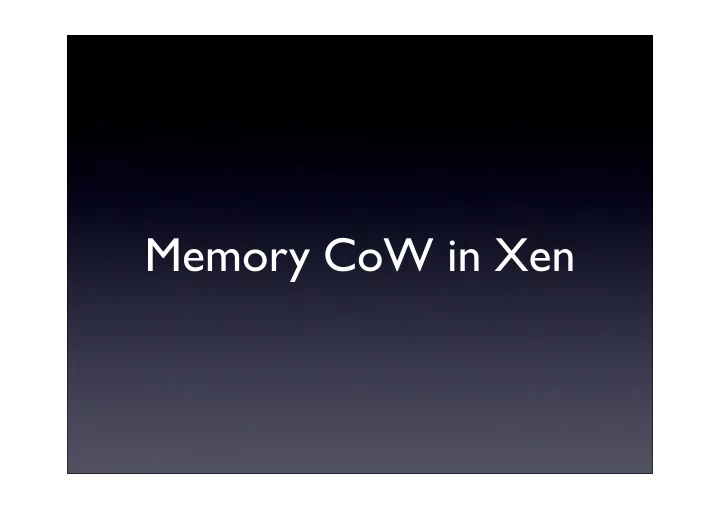

Memory CoW in Xen
Talk overview • Why is CoW need? • Memory CoW basics • CoW mechanism: • Establishing sharings • No-Copy-on-Write • Asynchronous memory reclamation • Conclusions
Why is memory CoW needed? • In VMMs there is a relatively large degree of memory duplication (Waldspurger claims 67% for synthetic, up to 42.9% on “real world” workloads) • Intra-domain duplication is already exploited by the OSes (CoW on fork, shared libraries, global page cache), but Inter-domain duplication is out of the guests’ reach
CoW basics • Once two pages are detected to have the same content, only one copy kept, mappings turned RO • On write fault create a private copy (unless there is only one mapping left) • Memory is needed to satisfy the write faults. At the worst case we might need all the freed memory back
CoW mechanism
CoW issues • How to design the low-level mechanism for sharing + fault handling? • How to find pages to share? • How to minimise the impact of CoW faults? • Where to get the memory to satisfy CoW write faults?
CoW and shadow PTs • Sharing difficult with direct page tables • Reverse mappings needed • Remapping (either to establish a sharing or to satisfy a fault) difficult • Shadow page tables already managed by the hypervisor, relatively easy to add OS agnostic reverse mappings • Write faults can be handled transparently • However PV guests don’t use shadow PTs by default
get_page => get_gfn • Xen memory management assumes exclusive ownership of pages (i.e. single owner), grant tables + direct foreign mappings handled as special cases • Synthetic cow_domain introduced (acts as an owner). All page gets/puts turned into GFN gets/puts (they take an extra domain argument) • gfn_info structures created to store counts for shared pages
share_mfns hypercall • Two extra hypercalls hypercalls added: mark_page_ro and share_mfns • share_mfns(source_mfn, client_mfn) prompts Xen to remap all client_mfn’s gfns to source_mfn • share_mfns fails if either source_mfn or client_mfn weren't previously marked RO with mark_ro(mfn)
Detecting duplicate pgs • Underlying principle: use cheap heuristics where possible, avoid content hashing • PV interfaces treated as a source of hints • CoW disk: the CoW relationships can be effectively brought into memory • location of shared libs? • CoW daemon in Dom0 aggregates hints, verifies duplication, administers share_mfns
No-Copy-on-Write • Let’s consider page allocation cycle: 1. a free page (content logically zero) is allocated 2. the page is freed 3. page is scrubbed [possibly] 4. goto 1. • If write fault in 1. or in 3. there is no need to copy as the page is logically zero
Repayment FIFO • Xen doesn’t overcommit memory, paging is the guests’ responsibility • Guest might be unable/unwilling to give up the memory required to resolve faults, repayment guarantees needed ahead of time • Guest maintained repayment FIFO containing volatile pages introduced, |FIFO| >= #bonus pages • IBM’s page hinting patch: volatile pages in Linux
Repayment FIFO in HVM • HVM domains can take advantage of extra memory indirectly • Service domains/Dom0 can usefully accommodate extra memory: e.g. a memory based swap file can be created • Repayment FIFO will be maintained by the service domain
Future directions • Filesystem level I/O (note JavaGuest project) • Read Only memory • Budy-like sharing: hashes for ^2 memory blocks, allows to efficiently share more then a single page • Domain building: forking a RO “domain stub” • Security consideration: CoW creates a new covert channel, need a way of protecting sensitive memory (e.g. ssh keys)
Questions?
Recommend
More recommend